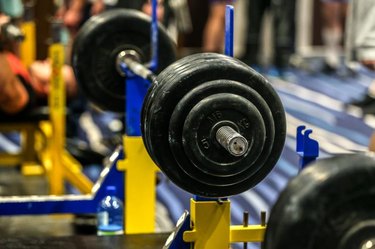
Think of the bench press as the ancient oak tree of the fitness world. It's solid, it's stood the test of time and it's grown a ton of branches. Those branches are, of course, a whole lot of benching variations.
You can bench with dumbbells, bench on an decline, bench on an incline and bench to your heart's content with all sorts of grips, with each tweak to the technique intensifying your engagement of specific muscles. With a wider grip, you're still reaping the basic benefits of the traditional bench press, but you put a little more focus on the outer chest muscles and may even increase the total amount of weight you can press.
Video of the Day
Video of the Day
The Basics
As a subtle variation on the standard, the flat bench press, a wide-grip technique still covers the same basics. This exercise puts most of its focus squarely on working the pecs (specifically the pectoralis major, or "lower pecs"), but the upper pectoralis major, the anterior deltoids of the front shoulder and the triceps are also engaged as synergists -- muscles that help other muscles complete a movement.
While those muscles are synergizing, the bench press also recruits the biceps as dynamic stabilizers. So you might just get invited to the gun show after all.
Read more: What Are the Benefits of Bench Presses?
The Benefits
A little shift in your grip, just a few inches beyond the standard barbell benching grip, also shifts the standard bench press' focal points a bit. This small tweak reduces the lift's range of motion, which places a bit more focus on the outer portions of your pecs, particularly the upper-pec muscles called the clavicular head.

Perhaps more noticeable than the difference in chest engagement is this variant's effect on how much total weight it helps you press. Though it's not a world-shaking difference, two well-respected studies — a 1995 article in "The Journal of Strength and Conditioning Research" and a 1992 piece in the "Journal of Applied Biomechanics" -- report that a wide grip might just enable you to increase your load capacity by 5 to 7 percent.
Though greater weight resistance makes for more challenge and potentially more muscle gains, this small percentage means that the wide-grip bench press caters more to powerlifters than gym dwellers seeking to tone up.
The Drawbacks
With less range of motion, you'll be putting more weight and torque on your shoulder joints when you use a wide grip. This is especially true if you make the common mistake of flaring out your elbows when you press, so if you have shoulder issues, you should probably skip this one.
If your grip is too wide, you risk reducing your range of motion a bit too much, which will decrease muscle engagement and could lead to improper execution of the exercise. To head off these complications, think of a wide grip as roughly elbow-width. If you're focusing on your triceps, it's worth noting that a wider grip also makes for less involvement of the tris.
Read more: Proper Bench Press Grip Width
Get a Grip
Just about anyone who's ever benched has an opinion on this staple chest workout, so tell us yours in the comments. How do you get a grip? Have you seen results from going wide, do you like to keep it standard, or are you on team narrow grip?
- ExRx.net: Barbell Bench Press
- Davey Wavey Fitness: Wide Grip vs. Narrow Grip Bench Press
- ExRx.net: Common Resistance Training Mistakes: Force Vector and Alignment Errors
- Tony Gentilcore: Five Ways to Make Bench Pressing More Shoulder Friendly
- University of Michigan: Biomechanical Analysis: Wide vs. Narrow Grip Bench Press
- ExRx.net: Bench Press Analysis
- The Journal of Strength and Conditioning Research: Effects of Variations of the Bench Press Exercise on the EMG Activity of Five Shoulder Muscles
- Journal of Applied Biomechanics: The Effect of Grip Width on Bench Press Performance